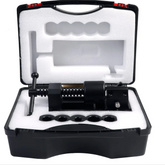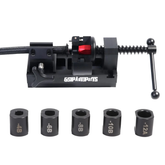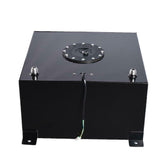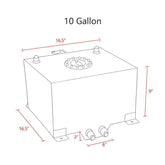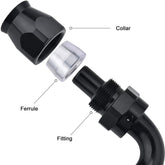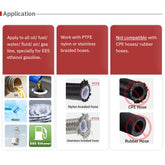Engine cooling systems are very complex and include several subsystems. One of these is the coolant recovery system, which ensures there is no air in the system and prevents coolant from spilling to the ground. Since air can cause cooling system components to rust and corrode, the presence of air in the system can lead to leaks in antifreeze, which contains ethylene glycol, which is harmful to the environment. As the coolant circulates through the cooling system, it picks up metal particles, which also leads to its classification as a hazardous material.
In a coolant recovery system, coolant is added to a separate plastic tank that is attached to the radiator. There are usually scales molded into the radiator that indicate the proper coolant level, usually checked when the engine is cold. However, not all systems are the same. There is an overflow tank system and an expansion tank system. In an overflow system, the pressure cap sits on the radiator, and the overflow tank has a simple plastic cover. Coolant can flow from the radiator to the recovery tank when the pressure in the radiator exceeds the pressure rating of the cap. When the temperature of the coolant drops, a vacuum is created in the system, which opens the vacuum valve in the pressure cap, allowing the coolant to be drawn back into the radiator.
The pressure cap is on the tank of the expansion tank system. Since the water tank is part of a pressurized cooling system, it is made of heavier reinforced plastic. In this system, the expansion tank is the highest point in the cooling system and has chambers built into it to allow the coolant to expand and contract according to temperature. A pressure cap functions the same as an overflow system, but when the pressure exceeds the pressure rating of the pressure cap, air is released instead of coolant, and when the coolant temperature drops and a vacuum is created in the system, atmospheric pressure forces the air back. Air won't be a problem with the system here because the tank sits above the radiator and doesn't aerate the coolant in this position.
Since proper functioning of the coolant recovery system is critical to the safe and efficient operation of the entire cooling system, regular system inspections are critical. We recommend that you check the coolant recovery tank regularly for cracks and any signs of leaks. Although these components are generally reliable, they can degrade due to aging and repeated thermal cycling. They can also become discolored from contaminated coolant, making it difficult to accurately determine the coolant level. If you notice any signs of coolant on the outside of the recovery tank, on the radiator cap, or on the engine, you should first check all the hoses and clamps. If everything looks good, your next steps should be to check the radiator cap and the recovery tank for damage.
If the recovery tank shows no signs of damage, pay special attention to the condition of the radiator cap, as even a brand new cap could be the source of the problem. Compare the pressure rating on the radiator pressure cap to the vehicle manufacturer's specifications to make sure it is the right fit for the vehicle. Wait for the system to cool completely, then remove the cap from the radiator or expansion tank. Check for damage to the sealing gasket, which would prevent the cap from maintaining pressure, and check the vacuum valve for damage, which would cause it to stick, preventing coolant from flowing back into the radiator and causing the hoses to collapse. Use the appropriate tester and adapter to pressure test the lid. The cap should hold the pressure at what it's rated for, then release, allowing the pressure to escape.
In a coolant recovery system, coolant is added to a separate plastic tank that is attached to the radiator. There are usually scales molded into the radiator that indicate the proper coolant level, usually checked when the engine is cold. However, not all systems are the same. There is an overflow tank system and an expansion tank system. In an overflow system, the pressure cap sits on the radiator, and the overflow tank has a simple plastic cover. Coolant can flow from the radiator to the recovery tank when the pressure in the radiator exceeds the pressure rating of the cap. When the temperature of the coolant drops, a vacuum is created in the system, which opens the vacuum valve in the pressure cap, allowing the coolant to be drawn back into the radiator.
The pressure cap is on the tank of the expansion tank system. Since the water tank is part of a pressurized cooling system, it is made of heavier reinforced plastic. In this system, the expansion tank is the highest point in the cooling system and has chambers built into it to allow the coolant to expand and contract according to temperature. A pressure cap functions the same as an overflow system, but when the pressure exceeds the pressure rating of the pressure cap, air is released instead of coolant, and when the coolant temperature drops and a vacuum is created in the system, atmospheric pressure forces the air back. Air won't be a problem with the system here because the tank sits above the radiator and doesn't aerate the coolant in this position.
Since proper functioning of the coolant recovery system is critical to the safe and efficient operation of the entire cooling system, regular system inspections are critical. We recommend that you check the coolant recovery tank regularly for cracks and any signs of leaks. Although these components are generally reliable, they can degrade due to aging and repeated thermal cycling. They can also become discolored from contaminated coolant, making it difficult to accurately determine the coolant level. If you notice any signs of coolant on the outside of the recovery tank, on the radiator cap, or on the engine, you should first check all the hoses and clamps. If everything looks good, your next steps should be to check the radiator cap and the recovery tank for damage.
If the recovery tank shows no signs of damage, pay special attention to the condition of the radiator cap, as even a brand new cap could be the source of the problem. Compare the pressure rating on the radiator pressure cap to the vehicle manufacturer's specifications to make sure it is the right fit for the vehicle. Wait for the system to cool completely, then remove the cap from the radiator or expansion tank. Check for damage to the sealing gasket, which would prevent the cap from maintaining pressure, and check the vacuum valve for damage, which would cause it to stick, preventing coolant from flowing back into the radiator and causing the hoses to collapse. Use the appropriate tester and adapter to pressure test the lid. The cap should hold the pressure at what it's rated for, then release, allowing the pressure to escape.

